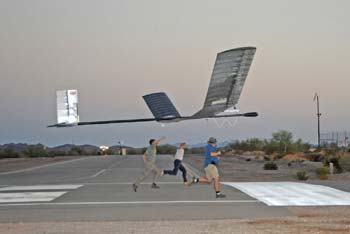Zephyr high-altitude long-endurance UAV sets world record for longest flight
26 Aug 2008
 The Zephyr, a unique solar-powered, high-altitude long-endurance (HALE) Unmanned Aerial Vehicle (UAV) has performed a three and a half day flight at the US Army's Yuma Proving Ground in Arizona, which constitutes a fresh record for this class of aircraft. The plane flew for 82 hours 37 minutes, beating the current official world record for unmanned flight, which stands at 30 hours 24 minutes set by Global Hawk in 2001.
The Zephyr, a unique solar-powered, high-altitude long-endurance (HALE) Unmanned Aerial Vehicle (UAV) has performed a three and a half day flight at the US Army's Yuma Proving Ground in Arizona, which constitutes a fresh record for this class of aircraft. The plane flew for 82 hours 37 minutes, beating the current official world record for unmanned flight, which stands at 30 hours 24 minutes set by Global Hawk in 2001.
It also surpassed its own previous longest flight of 54 hours achieved last year.
 Launched by hand, Zephyr is an ultra-lightweight carbon-fibre aircraft. The unique aspects of the UAV lies in the fact that by day it flies on solar power generated by amorphous silicon solar arrays no thicker than sheets of paper that cover the aircraft's wings.
Launched by hand, Zephyr is an ultra-lightweight carbon-fibre aircraft. The unique aspects of the UAV lies in the fact that by day it flies on solar power generated by amorphous silicon solar arrays no thicker than sheets of paper that cover the aircraft's wings.
By night it is powered by rechargeable lithium-sulphur batteries, which are re-charged during the day using solar power.
The flight trial at Yuma took place between 28 and 31 July in the harsh conditions of the Sonoran Desert in mid-summer with temperatures up to 45°C (113°F). Zephyr was flown on autopilot and via satellite communications to a maximum altitude of more than 60,000ft.
The trial included a military utility assessment of a US Government communications payload.
The Zephyr programme is a joint effort by the UK ministry of defence, which has actually funded the project to date, and has the US Department of Defense (DoD) as a partner under its Joint Capability Technology Demonstration (JCTD) Programme. This programme is dedicated to move urgently needed technologies rapidly into the hands of US forces in the field. JCTD projects are specially tailored to meet the needs of US combatant commands.
Zephyr is supported by US CENTCOM, the combatant command with responsibility for Iraq and Afghanistan, along with the Office of Secretary of Defense (OSD) for Advanced Systems and Concepts (AS&C) and the US Army Space and Missile Defense Command (SMDC).
Simon Bennett, managing director of QinetiQ's Applied Technologies business said: "The Yuma Proving Ground in Arizona was an appropriate setting for Zephyr's world beating flight as many landmark aviation developments have taken place there in recent years. In addition to setting a new unofficial record, the trial is a step towards the delivery of Zephyr's capability for joint, real-time, battlefield persistent surveillance and communications to forces in the field at the earliest opportunity."
Potential applications for Zephyr include earth observation and communications relay in support of a range of defence, security and civil requirements.






























